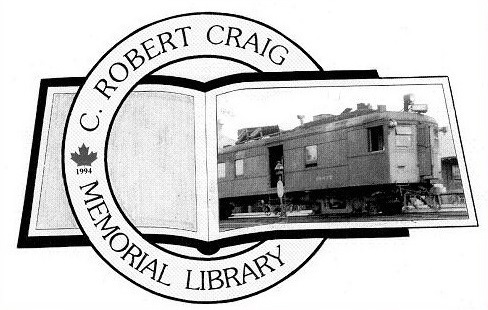CRCML history
 November 2nd, 2016
November 2nd, 2016
The beginnings
The Library was initially based on the donations from estates of two local enthusiasts: Bob Craig; and Ken Chivers.
C. Robert "Bob" Craig
Bob Craig, in whose memory the Library was named, was a life-long resident of Ottawa. He took a great interest in model railways at an early age, and his contagious enthusiasm for the hobby never waned. He built a large railroad in his basement and operated it, with the help of friends, as though it were a real railroad. He shared his love of the hobby and, in particular, "operations", with anyone who had similar interests.
Bob had a keen interest in railways as well as model railways and he amassed a large collection of books, magazines and photographs related to rail transportation. He had a phenomenal memory for the subject and was called upon frequently by his friends and acquaintances to answer questions regarding model railroading and prototype railroading. If he could not answer a question from memory he usually remembered where he had seen the information and would search it out. The Library attempts to carry on this tradition by providing reference materials to permit people to research the subject. Consequently the library collections are rich in material on the history of rail transportation and in the scale modelling of it.
Bob was one of seven founding members, in 1961, of the Ottawa Valley Associated Railroaders, (OVAR), an institution still thriving today. He supported it strongly throughout his lifetime.
Ken Chivers
Ken Chivers, another founding member of the Ottawa Valley Associated Railroaders, (OVAR) and a long-time friend of Bob Craig, was a keen railway historian and a prolific photographer. His documented photography collection, numbering about 9,000 colour slides and 3,000 black and white pictures is a vivid history of Canadian railways from the 1950s through the 1970s.
All of his photographs, including the negatives for the black and white pictures, are now part of the Library's holdings.
The C. Robert Craig Memorial Library Herald
In the early days of establishing the C. Robert Craig Memorial Library, a photo of Bob's favourite locomotive, the FM Trainmaster was drafted in to serve as a surrogate herald. With the passage of time a more appropriate symbol was needed. The new herald celebrates a significent Ottawa railway link.
The overall symbol of the herald is an open book with an open fold-out page surrounded by a circle bearing the Library's name.
The foldout page carries a photograph of the front of Canadian National Railway railcar #15817. The body of this railcar was one of nine built in 1925 by the Ottawa Car Manufacturing Company at its plant on the corner of Slater and Kent Streets in downtown Ottawa.
Two of the units, #15817 and #15818 were 102 foot long articulated units and the remaining seven were 60 foot single cars. The bodies were fitted with Beardmore diesel engines, National Steel Car trucks and electrical equipment from Westinghouse (articulated units) or British Thompson Houston (single units) at CN's Point St Charles shops in Montreal.
On September 19, 1925 Car # 15817 made an inaugural special run from Montreal to Ottawa via Coteau Junction, 110.2 miles in 2.25 hours. It entered regular service on September 28, 1925 as trains 85 & 86 between Montreal and Ottawa via St Eustache sur le Lac and Hawksbury. It was scheduled to leave Montreal at 8:20 am and arrive in Ottawa at 12:10. Ottawa departure was at 3:37 pm with arrival back in Montreal at 7:30 pm. A month later #15817 moved to Palmerston and was succeeded by #15918.
This series of cars were the first North American railcars to be powered by a combination of diesel engines and electric motors. Car #15817 remained in service until December 1942 when it was rebuilt to a trailer and renumbered 15773. Car #15818 suffered a similar fate in August 1944.
The Maple Leaf signifies the Canadian location and 1994 the year of the Library's foundation.
Supplemental information.
The Beardmore diesels so impressed Westinghouse that they purchased a licence and built them for railway use in the United States.
In June 1935 the Model Craftsman, now Railroad Model Craftsman, featured an article "An Articulated Train" with plans to build an "O' gauge #15817/8. Brass HO models of both CNR and CPR railcars and a Montreal and Southern Counties Railway car have been produced.
In 1931 and 1932 the Canadian Pacific railway received 6 railcars from the Ottawa Car Manufacturing Co. These were built to specifications and design of the Electromotive Company and powered by gasoline engines. However in mid-1935 a fire destroyed the engine in Car #9006 and it was replaced by a Harland and Wolff built diesel engine and became the first diesel-electric unit on the CPR.
Honour Roll
President:
Vice-President:
Secretary:
Treasurer:
Directors:
Other:
Web Manager:
